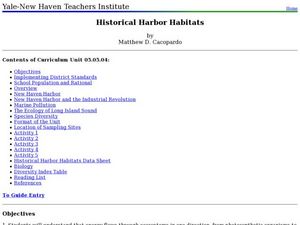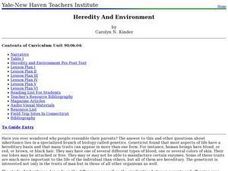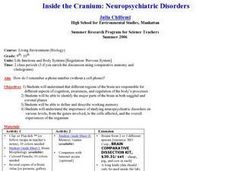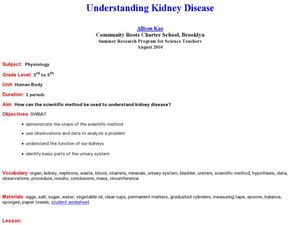Curated OER
Seeing in 3D: Interpreting Two-Dimensional Diagrams of Three-Dimensional Objects
Students hone in on their skills at reading diagrams. In this dimensional lesson students collect information on the functions of organs then figure out how all the parts work together.
Curated OER
Interdisciplinary Applications of Chemistry Through Engineering in Modern Medicine
Students explore the different techniques used in forensic science. In this chemistry activity, students investigate a fictional crime and identify the culprit. They create a brochure or collage career bulletin.
Curated OER
Cell-to-Cell
Ninth graders use online tutorials, class discussion, presentations and scientific articles to explore types of cells along with cell structure, function and behavior. They explore ethical questions related to cells and disease.
Curated OER
The Cell
Students study the basic processes by which cells divide and transfer their genetic information. They recognize and distinguish possible inherited traits and through the discovery method of the facts and principles of inheritance. this...
Curated OER
Sociobiology: Heredity Factors
Students examine DNA replication and how proteins are synthesized from DNA codes and continue to explore the effects of genetics in additional lessons. Among the topics covered are: protein synthesis, cell chemistry, environmental...
Curated OER
Basic Introduction to Foundation of Life: Genes, Genetics and Genetic Diseases
Students are introduced to genetics along with genetic diseases and heredity. In groups, they complete a Punnett Square to determine the dominant and recessive genes. After viewing diagrams, they identify the characteristics of DNA and...
Curated OER
Anger, Aggression and Adolescents
Students examine the relationship between anger, aggression and teenagers. As a class, they share a difficult situation in their own lives and review the techniques to properly deal with it. In groups, they discuss how they feel about...
Curated OER
Assisted Reproduction
Young scholars are actively involved in presenting some of the issues in implanting previously frozen embryos through a cooperative learning lesson plan. This lesson plan helps students to develop decision-making skills through...
Curated OER
Quick Concept Demonstrations
Students research the nervous system. Demonstrations on how to pick up keyed information in text is shown daily and weekly. Reviewed for content is Nerve Impulse, Polarization and Depolarization and perception. A spreadsheet will graph...
Curated OER
The Challenge to Deliver Insulin
Students study the types of diabetes and why insulin is important. For this diabetes lesson students build molecular models and create a healthy lifestyle plan.
Curated OER
Historical Harbor Habitats
Tenth graders create food web displays in the classroom. In this ecology lesson, 10th graders identify the different pollutants in the environment and their effect on organisms. They collect samples of sediments from the harbor and...
Curated OER
Science: Bees: An Interdisciplinary Approach
Young scholars investigate the world of bees and describe their characteristics. by identifying the bees' parts, they demonstrate how these parts function. In the lab, students dissect bees and view the various parts under microscopes....
Curated OER
Who am I and Why?
Students make comparisons about themselves and others, which are real and meaningful. They study some basic concepts in the area of genetics and do a complimentary series of experiments, or explorations that illustrate these concepts
Curated OER
Heredity And Environment
Students complete a pre-test on the relationship between heredity and the environment. As a class, they write down descriptions of themselves and identify which traits can be changed and not changed. In groups, they determine which genes...
Curated OER
The Barn Owl Pellet
Seventh graders examine the factors that affect the number and types of organisms that an ecosystem can support. In this ecosystem lesson students study the barn owl and where it is on the food chain, then dissect an owl pellet.
Curated OER
It's Alive! Using Microorganisms in Cooking
Students create a KWL chart about food. In this chemistry lesson, students differentiate physical and chemical changes. They explain how microorganisms are used in food preparation.
Curated OER
Inside the Cranium: Neuropsychiatric Disorders
Learners analyze different regions of the brain which are responsible for different aspects of cognition, awareness and regulating the body's process.
Curated OER
Process of Mitosis
Learners discover through whole-class role play, the process of mitosis. They will all become a chromosome and demonstrate how they line up 23 to 23.
Curated OER
Investigating the Method by Which the Body Defends Against Pathogens
Students explore disease caused by bacteria and viruses, how they are transmitted, and how they exert their effects on their hosts. They explain how diseases, such as AIDS, are spread by exponential growth.
Curated OER
Understanding Kidney Disease
Students experiment to determine information about kidney function. In this kidney function lesson, students use the scientific method to experiment with eggs, water, salt, sugar, and vegetable oil to simulate kidney function. They...
Curated OER
Human Development: The First Trimester & Developmental Malformations
Students, analyze and discuss cleft lip, cleft palate, anencephaly, spina bifida and septal defects in the heart--well-known malformations that can occur in the first trimester of prenatal devalopment. They play the review game, Fetal...
Curated OER
Using Video to Quantify a Reflex Response to a Stimulus
Learners examine the effects of a stimulus on a reflex by changing the strength or force at which the stimulus is applied. Students chart and record data of the lab using video tape.
Curated OER
Fiber and Water
In this human body worksheet, students determine why the body needs water and how the body uses the water. Students understand the importance of fiber in their diet and how the body uses fiber. This worksheet has 14 short answer and 7...
Curated OER
How Do Cells Reproduce?
Students discuss the importance of reproduction of cells. They identify and describe the stages of Mitosis. They discover what happens to chromosomes and DNA during reproduction.
Other popular searches
- Biology Unit Test
- Biology Unit Plans
- Plant Biology Unit Plans
- Biology Unit 1
- Biology Unit 3
- Biology Unit Cell
- Biology Unit 1 Review
- Biology Unit Classification
- Biology Unit Lesson Plan
- Biology Unit With Fiction
- Ib Biology Unit Plans
- Biology Unit (Ecology)

























